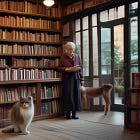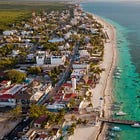Location, Location, Location: Our Mexico Bookstore Takes Root
Chapter 24: Staking our claim—our bookstore's first address
Hola Amigos! As time marched on, Paul and I prepped for our new venture—opening a bookstore in Puerto Morelos. Unbelievably, Quintana Roo had only seven bookstores in the entire state—none anything to write home about. Back then, Puerto Morelos was unknown. Truly. Even though 30 kilometers south of Cancun, when Cancunese asked where we were from, they hadn’t heard of Puerto Morelos! Just a two minute drive off Highway 307, it didn’t even warrant a road sign with arrow pointed towards the beach. Quien sabe? Who knows why. We used to call it the land that time forgot. Some asked why not open our bookstore in Cancun where there were actually tourists. No, we wanted the store in our little fishing village, plus we’d be close to our work when the time finally came. But back in San Francisco, we still had mucho time before our move to Mexico so we threw ourselves into book buying. Here’s another chapter on our slo-mo journey to becoming expats on Mexico soil and landing an address for our Alma Libre Libros storefront.
Along with our newfound addiction of searching out good used books for Alma Libre Libros (no tattered covers, no underlining, no broken bindings, no torn pages), I busied myself with reading more about the Maya, seeking out any information I could find.
I also became interested in the flora and the fauna of tropical rainforests. The University of Oklahoma Press was a fantastic source on all things Mexican, Aztec and Mayan. I signed up for their quarterly book announcements and continued collecting in this area of interest. In the meantime, we lived and breathed Mexico.
After meeting Sarah at the Friends of the Library sale, I realized how many good people the book trade included . . . many more than the handful of wily, overzealous dealers we occasionally came in contact with. Years earlier, while living in Mendocino County, I worked for a small publisher who told me people in the book trade were quality types.
Before moving to California with his wife and children, he’d worked in Manhattan as an administrator in the NY public library system. In his job he dealt with antiquarian book dealers. He told me hundreds of thousands of dollars passed between the antiquarian sellers and no one ever got burned. If a book was quoted as “near perfect condition,” it would arrive in near perfect condition. They were true to their word.
I was familiar with this code of honor from 84 Charing Cross Road, the quintessential read on the used book trade, delivered in a series of letters written over 20 years between a New York writer and a book dealer in London after World War II.
Before opening my bookstore I’d called my old college advisor with whom I’d kept in touch. He had two suggestions as I researched the book business: Go to Powell’s Bookstore in Portland, Oregon, the largest used bookstore in the US, and read 84 Charing Cross Road. I followed through.
True to her word, Sarah saved us boxes of excellent books in numerous topics. All we had to do was mention a genre and it was like manna from heaven—books miraculously appeared at her cubbyhole office in the back of the library. We checked with her twice a month to see what she’d accumulated.
I slowly realized we were gathering an assortment of truly fine books. Genre by genre, we were building up our stock. Paul and I had already input the books we’d purchased from our first buy into our new software program and placed them in empty Xerox boxes I’d collected from work. After buying books, we’d come home, input titles, and toss them into a box marked for each specific genre.
One Friday Paul took the mysteries in our book cache from our original buy into a little known San Francisco shop that dealt solely in mysteries. It was a charming store, housed in an old cottage in Noe Valley. Inside, the walls were covered with movie posters of Dashiell Hammer thrillers—The Maltese Falcon, The Glass Key, The Thin Man, very 40s retro.
He sold an assortment to the owner, then went to a bookshop in Haight-Ashbury that specialized in science fiction and sold off countless sci-fi magazines we’d bought with our first collection. Whatever money we gained from these sales we put right back into book buys but for different genres.
While on a day trip down the coast, we stopped in to see Mildred at Yesterday’s Books in Moss Landing. We told her we were acquiring quite an assortment, most now in boxes. She shared her method for storing books which assured a mold-free environment, something that would be a necessity in southern Mexico.
“Go to any flower shop and this is what you’ll look for,” she said.
It was a spring day in California. The winter rains had stopped, at least temporarily. Paul and I had enjoyed the drive down the coast on Highway One, taking in bucolic scenes of meadows alive with California poppies and purple lupines.
“They sell various kits for flower arrangements and along with these, they sell crystals that absorb the moisture and keep flowers perky,” she said as she patted the back of her hair. In anyone else I would have considered this primping, but not in Mildred. She was too prudent for that.
“Make up a little pouch of the crystals in a piece of cheesecloth, tie it with string or use a rubber band to secure it, and drop it in the box with your books.
“You’ll be amazed how it keeps the pages crisp. It’s a sure-fire method for book storage, one of the best.”
Mildred should know, I thought, as I gazed again at the countless volumes in her quaint, wood frame bookshop. How many books had passed through her hands, I wondered?
Prepping books, buying books, cataloging books, and boxing books became quite a job. Now we would also prepare a little cheesecloth bag filled with flower arranging crystals and drop that into each box.
By this time we had outgrown our spare bedroom for our budding inventory due to sheer volume. We rented a storage warehouse in Redwood City where the book boxes would sit until the day we shipped them to Mexico. After filling eight to 10, all assorted by genre and secured with packing tape, Paul would cart them off to the warehouse. Our back room always had half-filled boxes of books.
Along with buying paperbacks we also bought hardbacks. Although weighty, our book guru mentioned how attractive they look on store shelves, so we kept our eyes open for current titles. For shelves, the guru said only wooden shelves would do, which we agreed with wholeheartedly. Once we found a storefront in Mexico, we would have Arturo fashion shelves to fit the space, floor to ceiling.
Another fact we learned was that 60 percent of books in a bookstore never sell—they merely hold up the shelves, according to the guru. He explained that without them, a customer won’t feel like they’re in a bookstore, so these books are a necessity. Looks are everything.
When I gazed at the countless boxes we’d accumulated both at home and in Redwood City, I realized we were going to have one sizable store.
Time moved along and we continued our buying spree. One year crept into another and while down in Puerto Morelos for Christmas in 1995, I asked Joe Marino if he knew of any storefronts for rent.
“The video store in the middle of my plaza on the square is going out of business in a few months. What are you looking for?”
“The bookstore,” I admitted.
“Well, gotta hand it to you. It’s unique. English or Spanish?”
“Predominantly English because it will mostly be my hobby. You know I love to read. If I don’t have any business I’ll just hang a hammock in the back and read all day. It sounds perfect to me. We’ve already collected over twelve thousand books.”
“You gotta be kidding.”
“No, she really has that many,” Paul said. “She’s been collecting books for over a year.”
“Whew. Well, I’ll let you know when the video space is available. It’s a good location. Rent is $90 USD a month.”
“That’s great, sure.” I couldn’t believe the price!
At least the rent wouldn't kill me. It was about half the cost of my Bay Area storage warehouse where the books were presently housed.
Within six months the video store closed and even though we wouldn’t be moving south for another two years, we started paying rent on a space in the middle of Plaza Morelos, right in front of the zocalo. We had a dead-on view of the enormous almendron tree in the park and the children’s jungle gym, the basketball court and a handful of park benches.
In time Paul would come to call this view, Ground Hog’s Day, as in the Bill Murray film where everything happened exactly the same as the day before. To the letter. But that’s why people move to small towns, I mused, to replicate the known on a daily basis.
And with that in mind, I could not wait to move to our little fishing village.
By 1997 the months were flying by. Our book cache approached the fifteen thousand mark. My goodness, how were we going to move them from San Francisco to Puerto Morelos? It was time to consider logistics. We called Joe again for advice, vaguely remembering his earlier assertion.
“Just ship them down, say they’re for your personal library and see what happens. Don’t bother to provide paperwork. They’ll work something out; it’s done all the time,” he assured us, again.
“But fifteen thousand books? What about all the information we’re supposed to have? Like receipts, manifests, stuff like that?” I asked.
“The Mexican Consulate says we need that to qualify for a one-time exemption from paying customs tax if you’re planning to make Mexico your permanent residence, which we are.”
“Just pack everything! And remember, the shipper is Hybur Trade in Florida.”
“I’ll check with them, then l have to line up a cross-country freight line. We have pallets and pallets of books. This will not be cheap. No one is that crazy.”
“Only you!” Joe said with a laugh. “Well, at least it will keep you busy.”
“I view this as a very expensive hobby. My own personal library—in 20 genres. Some people have race horses or expensive cars. Me, I’ll have a bookstore in the Yucatán.”
We decided to go with Joe’s assertion that little would be needed by Mexican customs to clear fifteen thousand used books shipped from San Francisco to our dock in Puerto Morelos. After lining up a freight company we rented a flatbed truck to cart the books from the warehouse to Fremont where the freight line was located.
We had five tons of books! They were loaded onto a commercial truck, USF Reddway, and we waved goodbye to three years of hard work. Our books were on their way.
We counted the weeks until we could leave San Francisco and drive with our kitten, Max, to Quintana Roo. After a flurry of retirement parties we said good bye to family and friends, packed what was left of our earthly belongings into our 1997 Ford Escort wagon, and headed south.
If you’re interested in supporting well-researched and thoughtful writing and you’ve been enjoying my posts and are in the mood to be generous, your paid subscription would make my day. Keep up to date on Mexico, travel, chapters from Where the Sky is Born—how we bought land and built a house on the Mexico Caribbean coast. And opened a bookstore, too! All for $5/monthly or $50 per year.
Hit the heart at the top of this email to make it easier for others to find this publication and make me very happy.
Backstory—Puerto Morelos sits within 100 miles of four major pyramid sites: Chichen Itza, Coba, Tulum and Ek Balam. By living in close proximity to this Maya wonderland we pyramid hopped on our days off from Alma Libre Libros, the bookstore we founded in 1997. Owning a bookstore made it easy to order every possible book I could find on the Maya and their culture, the pyramids, the archeologists who dug at these sites and the scholars who wrote about them, not to mention meeting archeologists, tour guides, and local Maya who popped into the store. I became a self-taught Mayaphile and eventually website publishers, Mexican newspapers and magazines, even guidebooks asked me to write for them about the Maya and Mexico. I’ll never stop being enthralled by the culture and history and glad there’s always new news emerging for me to report on right here in Mexico Soul. Please share this post if you know others interested in the Maya. Thank you!
Related Posts:
If you enjoyed this post, you might also be interested in reading:












Wow, Jeanine, 15,000 books!!! Good for you. I like the idea of lying in the hammock if customers don't show up often. BTW, when I had the idea of a tiny bookstore in Ajijic, Mexico, in 2012, the concept was to offer books on consignment from local authors. I offered free cups of coffee and sips of some very good wine from the Baja wine country, and I tried to sell bottles of the good stuff. Unfortunately, the resident retired gringos and the snowbirds wanted cheap wine from a local store. Apparently, I'm not a merchant and my venture lasted less than three months. I abandoned the concept and moved to Guadalajara.
This is such a fun journey you're taking us on, Jeanine! The photos included add to the charm. It's been a few years since I've ventured into Powell's Bookstore in Portland. I remember the first time I visited, I thought I was in heaven.